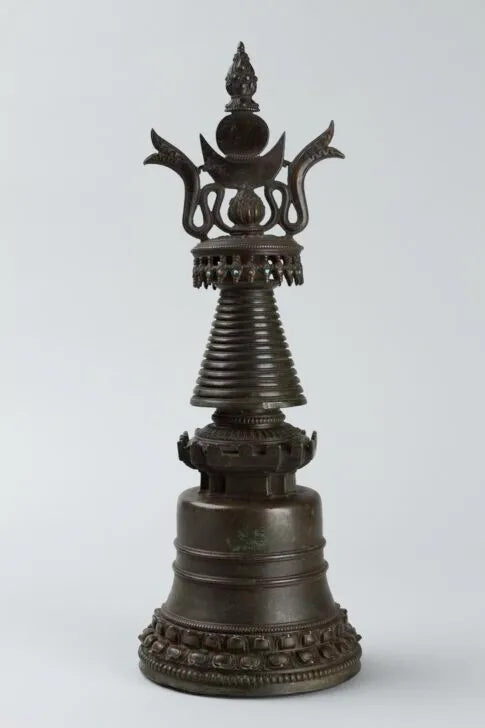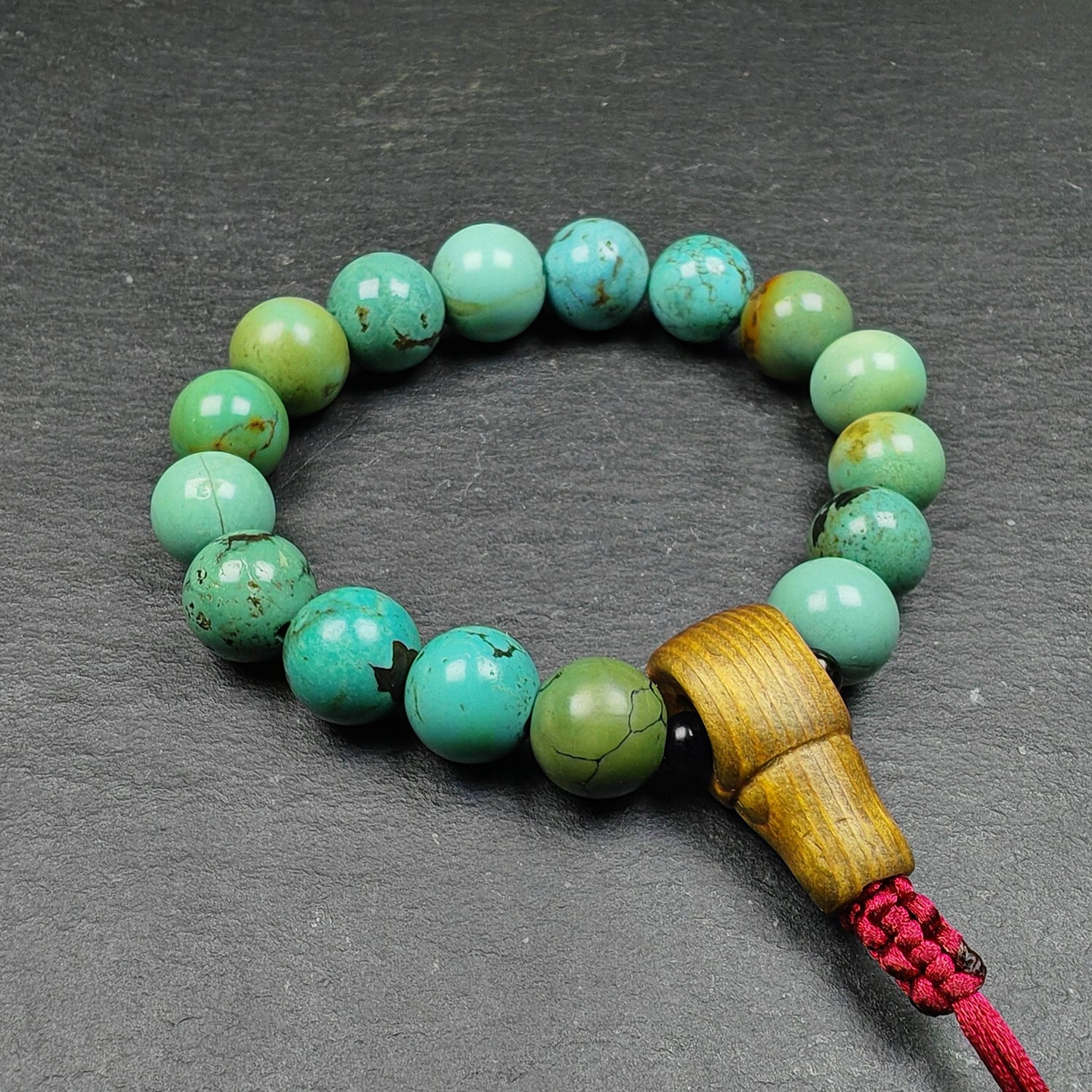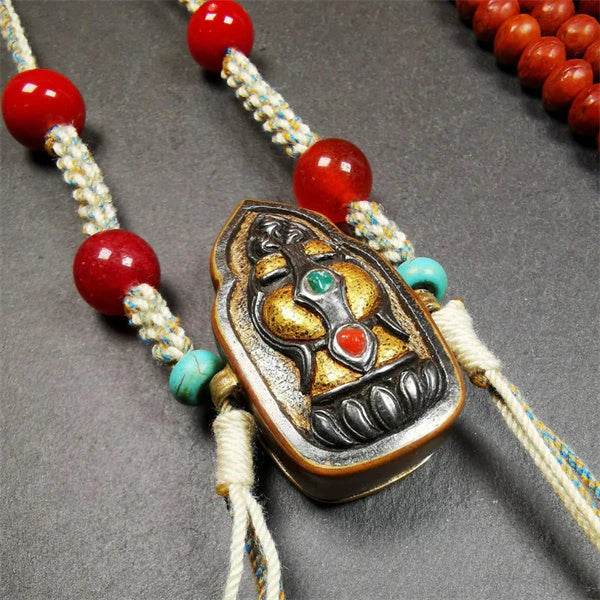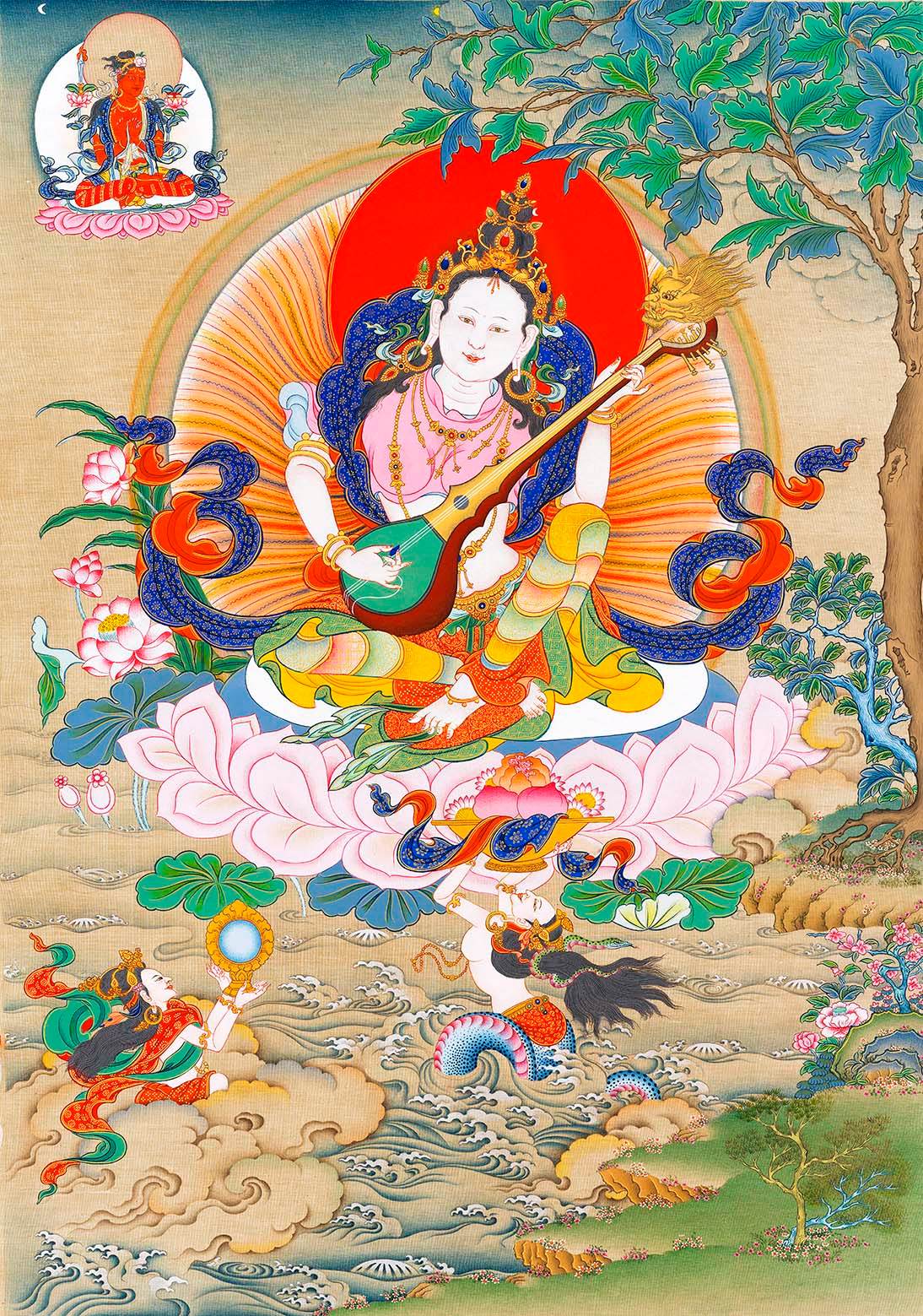
Gadan Tower ▎Master's Mark

The Jewel-Adorned Gadan-style Stupa
13th–14th century
Rubin Museum of Art Collection

Master Atisha, Founder of the Kadam School
Mid to late 17th century
Newark Museum Collection

Detail above: Kadam-style Stupa
དབུས་སུ་ཇོ་བོ་རྗེ་སྐུ་ཤིན་ཏུ་མཛེས་ཤིང་བརྗིད་ཆགས་པ།
(……)
གཡས་སུ་བཀའ་གདམས་མཆོད་རྟེན་
དང་གླེགས་བམ་འགའ་རེ་བརྩེགས་པ།
འཁར་གསིལ།གཡོན་དུ་ཟ་མ་ཏོག།
"The majestic and sublime one, Atisha at the center,
(...)
To his right, a Kadam stupa and some scriptures,
Beside him, a meditation staff, and to his left, a treasure casket."
—Excerpt from *"Inscription on the Thangka of the Kadam Patriarchs' Lineage"* (བཀའ་གདམས་ཞལ་ཐང་བྲི་ཡིག།)
By Jamyang Khyentse Chökyi Lodrö (འཇམ་དབྱངས་མཁྱེན་བརྩེ་ཆོས་ཀྱི་བློ་གྲོས་; 1893–1959)

Kadam-style Stupa
Mid-13th century
University of Michigan Museum of Art Collection
"The Kadam-style Stupa (བཀའ་གདམས་མཆོད་རྟེན་, also known as the Kadam-style Reliquary)
is generally regarded in Tibet as a testament to the deeds of Master Atisha (982–1055).
For early art historians,
the Tibetan Kadam stupa appeared to be a variation of one of the **"Eight Stupas of the Buddha"**—
specifically, the **Nirvana Stupa (མྱང་འདས་མཆོད་རྟེན་)**.
However, as academic research on Tibetan stupa architecture deepens,
the origins of the Kadam stupa’s name, its formal evolution,
and even its unique status in Tibet’s long history
must be re-examined based on textual and visual sources."

Kadam-style Stupa
12th–13th century
Mindrolling Monastery Collection, Lhoka
Historically, scholars from various Tibetan Buddhist traditions have praised this stupa extensively.
Ngari Panchen Pema Wangyal (མངའ་རིས་པཎ་ཆེན་པད་མ་དབང་རྒྱལ་; 1487–1542) of the Nyingma school
declared that this stupa signifies "Tibet has become a second Buddha-land."
Taktsang Lotsawa Sherab Rinchen (སྟག་ཚང་ལོ་ཙཱ་བ་ཤེས་རབ་རིན་ཆེན་; 1405–1477) of the Sakya school
stated that it symbolizes "the teachings transmitted in Tibet are perfectly clear and stainless."
The Third Tukwan, Lobsang Chökyi Nyima (ཐུའུ་བཀྭན་བློ་བཟང་ཆོས་ཀྱི་ཉི་མ་; 1737–1802),
praised the Kadam stupa not only for "manifesting perfect Nirvana"
but also as "the embodiment of the body, speech, and mind of all yidams and lineage masters."
He once commissioned three copper Kadam stupas for his teacher, the Sixth Panchen Lama.

Kadam-style Stupa
Mid to late 19th century
Zanabazar Museum of Fine Arts, Mongolia

The Eight Auspicious Stupas of the Buddha
Late 20th century, woodblock print
Detail: Nirvana Stupa / Great Perfection Stupa
The term "Kadam Stupa" appeared relatively late.
In some 14th to 15th century texts,
similar stupas were referred to as "Jowoje Stupa" (ཇོ་བོ་རྗེའི་མཆོད་རྟེན་, i.e., Atisha Stupa).
There are three reasons for associating this type of stupa with Atisha:
First,
Atisha himself once fashioned stupas to make offerings to his yidam deities,
and the stupas he carried with him were used to commemorate his teachers.
Most texts do not specify the design of these stupas,
sometimes describing them as "Lotus Heap Stupas," other times as "Nirvana Stupas."

Kadam-style Stupa
Late 14th century
Private Collection
From Mysticism in Tibet
Second
After Atisha's passing, his disciples built reliquary stupas in his honor.
When disciple Dromtönpa (1004-1064) established Reting Monastery,
he "constructed stupas with the master's relics for worship."
These reliquary stupas appear to have resembled the "Kadam Stupa"
(later often used as reliquary stupas).
Third
Atisha, who journeyed from afar, not only spread teachings and composed texts
but also introduced stupa styles prevalent across South Asia to Tibet
(primarily those of Pala art).
Having studied in Suvarnadvīpa (གསེར་གླིང་, present-day Sumatra),
the design of the "Kadam Stupa" was likely shaped by multiple influences.
Thus, attributing the stupa's origins to Atisha is well-founded.
The "Kadam Stupa" we recognize today
is more likely a localized adaptation of the stupa forms transmitted by the master.

Kadam-style Stupa
14th century
Private Collection

The Kadam Lineage: Master Atisha
Mid to late 15th century
Arnold Lieberman Collection

Detail above: Kadam-style stupa beside the Master
The Kadam stupa appears sometimes left, sometimes right behind the Master
Therefore, the Kadan Pagoda cannot be completely equated with the Nirvana Pagoda, and the fixed relationship between the two was established relatively late. Although the text traces the Kadan Pagoda back to the 11th century, the 13th century was an important period for its widespread appearance. The existing physical objects were mostly made in the 14th century, without a Mihang seat, with a low base and a lotus layer around it, which is in line with the theory that the Kadan Pagoda was originally a "hand-dragged pagoda". The inverted bowl shape is generally geometrically round or bell-shaped. The tall pagoda body, with the pagoda slightly up and down, reflects the traditional style. In traditional studies of craftsmanship, scholars have divided the Kadan Pagoda into three types: standard (unspecified), pointed top, and rounded top. Pagodas with pointed tops are classified as pointed top style, while those with pagoda tops resembling lotus buds or pearls are classified as rounded top style.

Kadam-style Stupa
Mid-14th century
Private Collection







8 comments
Visa
ajslhkpjd
[url=http://www.gx1q4b9903aab8t5olm5m18146t8zkr8s.org/]ujslhkpjd[/url]
jslhkpjd http://www.gx1q4b9903aab8t5olm5m18146t8zkr8s.org/
Visa
[url=http://www.gkqn1szfy736259wk6q804g7ys570q6bs.org/]upspeqnhrto[/url]
pspeqnhrto http://www.gkqn1szfy736259wk6q804g7ys570q6bs.org/
apspeqnhrto
Visa
[url=http://www.gi1966wr3ve3451h93u1a2d8cyjm91lqs.org/]uoltkxczmei[/url]
oltkxczmei http://www.gi1966wr3ve3451h93u1a2d8cyjm91lqs.org/
aoltkxczmei
Visa
crbocxld http://www.g9y5knvx7v4vghy0580v87069c8l50its.org/
acrbocxld
[url=http://www.g9y5knvx7v4vghy0580v87069c8l50its.org/]ucrbocxld[/url]
Visa
cklyqnq http://www.gq17zm9l5je817w89pg1aaz28z59yr00s.org/
[url=http://www.gq17zm9l5je817w89pg1aaz28z59yr00s.org/]ucklyqnq[/url]
acklyqnq